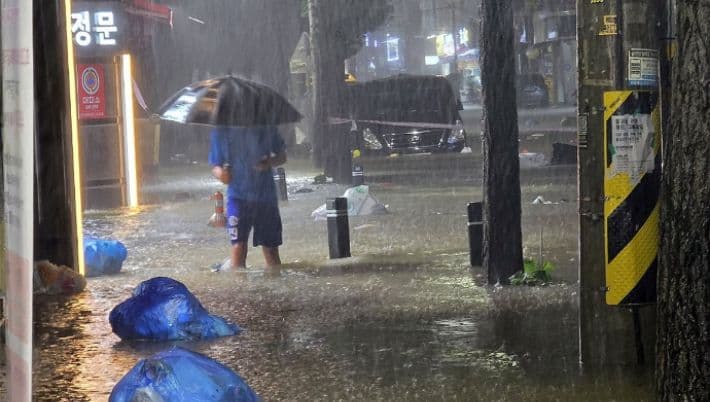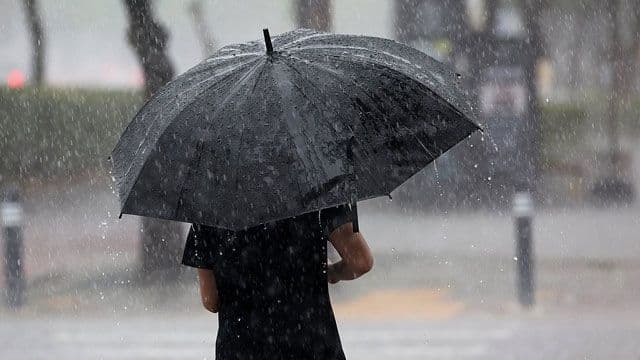Weather Whiplash: Navigating Korea's Shifting Summer Skies
Unpack Korea's bewildering summer weather: intense rain post-monsoon, then sudden heat. Discover why the climate is changing and how 날씨누리 helps you prepare and stay safe.

The Monsoon's Paradox: When "Over" Isn't Over
South Korea's summer weather has taken an alarming turn, defying traditional seasonal expectations. While the official monsoon season, known as Jangma, might be declared over in certain regions, the skies often have other plans. Recent weeks have seen regions like and inundated with record-breaking daily rainfall, exceeding 400mm in a single day – figures unseen since observational records began in 1939. Cumulatively, areas have been deluged with over 500mm of rain within days. This isn't just heavy rain; it's what meteorologists term 'extreme downpours' (극한호우), where rainfall can hit 100mm per hour, a volume capable of sweeping away vehicles. Emergency disaster alerts, or 'Ho-u Geunggeup Jaeanan Munja,' have become a common, urgent notification across metropolitan areas like and southern provinces, signaling severe localized flooding and the very real threat of landslides. It's a stark reminder that the 'end' of the monsoon no longer guarantees a respite, leaving communities grappling with a persistent, and often intensifying, deluge.

From Deluge Alerts to Heatwave Warnings: A Swift Transition
Just as the incessant rain begins to taper off, South Korea braces for the other extreme: a sudden, intense heatwave. The transition is remarkably swift, often within a day. As the heavy rain warnings lift, temperatures are forecast to surge, with expecting 31°C and cities like , , and soaring to 34°C, a significant jump from the preceding days. Looking ahead, the forecast points to a full-blown return of sweltering heat and tropical nights, where morning temperatures remain above 25°C and daytime highs consistently exceed 33°C, triggering heatwave advisories. This rapid swing from 'water bombs' to 'steaming heat' creates a challenging environment for public health and safety. Preparing for heat-related illnesses, such as heatstroke, becomes paramount, as does vigilance against food poisoning, which thrives in high temperatures. This 'weather whiplash' is not merely an inconvenience; it's a critical public health concern that demands immediate adaptation and preparedness strategies.

Unpacking the Anomalies: Why Korea's Weather is Reaching Extremes
So, what's behind this dramatic and unpredictable weather? Meteorological experts suggest these extreme patterns are fast becoming the 'new normal.' Over the past five decades, the frequency of concentrated heavy rainfall events during Korea's summers has increased nearly tenfold, with 'extreme downpours' exceeding 100mm per hour occurring 16 times last year alone, often outside the traditional Jangma period. The primary culprit appears to be , specifically the rising sea surface temperatures around the and the . This warming invigorates the , a powerful high-pressure system that, when strengthened, pulls in vast amounts of tropical moisture. Historically, Jangma was a delicate 'tug-of-war' between this high-pressure system and colder northern air masses. Now, with the North Pacific High's intensified strength, this balance is disrupted, leading to unpredictable and often devastating clashes that unleash unprecedented rainfall. This shift also hints at a potential 'autumn Jangma,' signaling that heavy rain events are no longer confined to the typical summer months.

Beyond the Forecast: Empowering Safety with "날씨누리"
In an era of such volatile weather, platforms like , the 's comprehensive weather portal, become indispensable tools for public safety. While not explicitly mentioned by name in the source, the concept of real-time weather information and emergency alerts is central to its function. The constant stream of 'emergency disaster text messages' for torrential rain, as seen in areas like , , and , are direct outputs of advanced meteorological monitoring and communication systems. These alerts, alongside specialized apps like 'Smart Forest Disaster' for landslide warnings, provide critical, actionable intelligence. Knowing the tell-tale signs of a potential landslide – ground tremors, trees shaking without wind, muddy water in streams, falling rocks – combined with immediate access to information from such platforms, empowers citizens to evacuate to designated shelters like community centers or schools. Beyond just forecasting, these digital tools are the frontline in translating complex meteorological data into practical, life-saving guidance for a population navigating an increasingly unpredictable climate.
Building Resilience: Preparing for a Climate of Unpredictability
The 'weather whiplash' South Korea experiences is a stark call to action for building greater societal resilience. With extreme rainfall and intense heatwaves now recurring features of summer, a proactive approach is no longer optional but essential. This means not only relying on immediate alerts from platforms like and 'Smart Forest Disaster' but also integrating long-term climate adaptation strategies into daily life and infrastructure planning. For individuals, this translates to consistently checking forecasts, understanding the thresholds for severe weather warnings (e.g., 33°C for heatwave advisories, 30mm/hr for heavy rain), and knowing emergency procedures for both floods and heat. Avoiding outdoor activities during peak heat and heavy rain, ensuring proper hydration, and being vigilant about food safety are simple yet crucial steps. For communities, it involves robust urban planning to manage runoff, reinforce vulnerable infrastructure against both deluge and drought, and foster a culture of preparedness where neighbors look out for one another. Only by embracing this 'new normal' and investing in comprehensive resilience can South Korea navigate the escalating challenges of its shifting summer skies.
Related Articles

South Korea's Shifting Skies: Navigating an Era of Extreme Weather

South Korea's Shifting Skies: Navigating an Era of Extreme Weather

Korea's Summer Climate Puzzle: Heatwaves, Deluges, and the Art of Prediction

Korea's Summer Climate Puzzle: Heatwaves, Deluges, and the Art of Prediction

Decoding the Dual Extremes: Korea's Summer of Sweat and Storms

Decoding the Dual Extremes: Korea's Summer of Sweat and Storms

The Unyielding Embrace: How Korea's Historic Heatwave Reshapes Everyday Life
